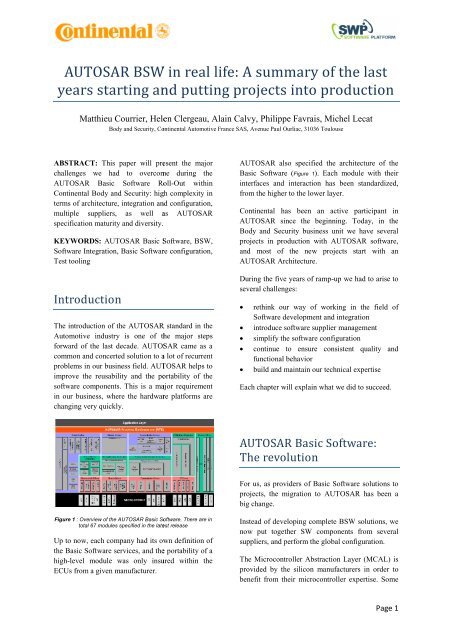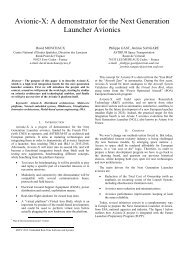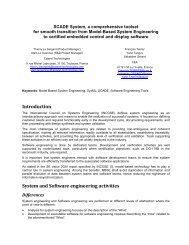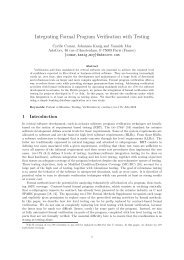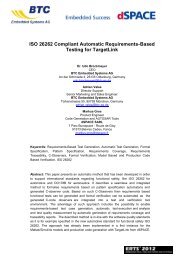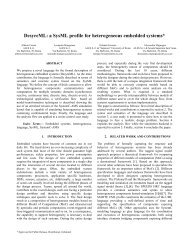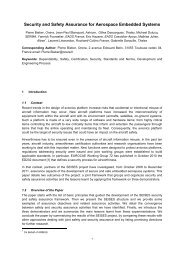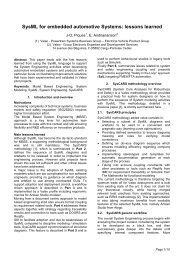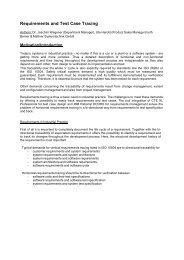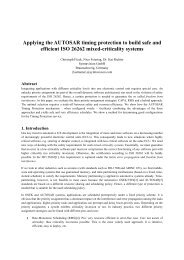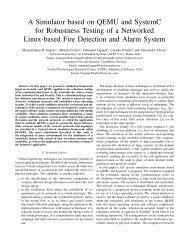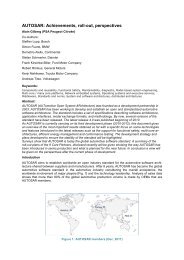AUTOSAR BSW in real life: A summary of the last years - Embedded ...
AUTOSAR BSW in real life: A summary of the last years - Embedded ...
AUTOSAR BSW in real life: A summary of the last years - Embedded ...
Create successful ePaper yourself
Turn your PDF publications into a flip-book with our unique Google optimized e-Paper software.
Matthieu Courrier, Helen Clergeau, Ala<strong>in</strong> Calvy, Philippe Favrais, Michel Lecat<br />
Body and Security, Cont<strong>in</strong>ental Automotive France SAS, Avenue Paul Ourliac, 31036 Toulouse<br />
ABSTRACT: This paper will present <strong>the</strong> major<br />
challenges we had to overcome dur<strong>in</strong>g <strong>the</strong><br />
<strong>AUTOSAR</strong> Basic S<strong>of</strong>tware Roll-Out with<strong>in</strong><br />
Cont<strong>in</strong>ental Body and Security: high complexity <strong>in</strong><br />
terms <strong>of</strong> architecture, <strong>in</strong>tegration and configuration,<br />
multiple suppliers, as well as <strong>AUTOSAR</strong><br />
specification maturity and diversity.<br />
KEYWORDS: <strong>AUTOSAR</strong> Basic S<strong>of</strong>tware, <strong>BSW</strong>,<br />
S<strong>of</strong>tware Integration, Basic S<strong>of</strong>tware configuration,<br />
Test tool<strong>in</strong>g<br />
<br />
The <strong>in</strong>troduction <strong>of</strong> <strong>the</strong> <strong>AUTOSAR</strong> standard <strong>in</strong> <strong>the</strong><br />
Automotive <strong>in</strong>dustry is one <strong>of</strong> <strong>the</strong> major steps<br />
forward <strong>of</strong> <strong>the</strong> <strong>last</strong> decade. <strong>AUTOSAR</strong> came as a<br />
common and concerted solution to a lot <strong>of</strong> recurrent<br />
problems <strong>in</strong> our bus<strong>in</strong>ess field. <strong>AUTOSAR</strong> helps to<br />
improve <strong>the</strong> reusability and <strong>the</strong> portability <strong>of</strong> <strong>the</strong><br />
s<strong>of</strong>tware components. This is a major requirement<br />
<strong>in</strong> our bus<strong>in</strong>ess, where <strong>the</strong> hardware platforms are<br />
chang<strong>in</strong>g very quickly.<br />
<strong>AUTOSAR</strong> also specified <strong>the</strong> architecture <strong>of</strong> <strong>the</strong><br />
Basic S<strong>of</strong>tware ( Figure 1). Each module with <strong>the</strong>ir<br />
<strong>in</strong>terfaces and <strong>in</strong>teraction has been standardized,<br />
from <strong>the</strong> higher to <strong>the</strong> lower layer.<br />
Cont<strong>in</strong>ental has been an active participant <strong>in</strong><br />
<strong>AUTOSAR</strong> s<strong>in</strong>ce <strong>the</strong> beg<strong>in</strong>n<strong>in</strong>g. Today, <strong>in</strong> <strong>the</strong><br />
Body and Security bus<strong>in</strong>ess unit we have several<br />
projects <strong>in</strong> production with <strong>AUTOSAR</strong> s<strong>of</strong>tware,<br />
and most <strong>of</strong> <strong>the</strong> new projects start with an<br />
<strong>AUTOSAR</strong> Architecture.<br />
Dur<strong>in</strong>g <strong>the</strong> five <strong>years</strong> <strong>of</strong> ramp-up we had to arise to<br />
several challenges:<br />
<br />
reth<strong>in</strong>k our way <strong>of</strong> work<strong>in</strong>g <strong>in</strong> <strong>the</strong> field <strong>of</strong><br />
S<strong>of</strong>tware development and <strong>in</strong>tegration<br />
<br />
<strong>in</strong>troduce s<strong>of</strong>tware supplier management<br />
<br />
simplify <strong>the</strong> s<strong>of</strong>tware configuration<br />
<br />
cont<strong>in</strong>ue to ensure consistent quality and<br />
functional behavior<br />
<br />
build and ma<strong>in</strong>ta<strong>in</strong> our technical expertise<br />
Each chapter will expla<strong>in</strong> what we did to succeed.<br />
<br />
<br />
For us, as providers <strong>of</strong> Basic S<strong>of</strong>tware solutions to<br />
projects, <strong>the</strong> migration to <strong>AUTOSAR</strong> has been a<br />
big change.<br />
Figure 1 : Overview <strong>of</strong> <strong>the</strong> <strong>AUTOSAR</strong> Basic S<strong>of</strong>tware. There are <strong>in</strong><br />
total 67 modules specified <strong>in</strong> <strong>the</strong> latest release<br />
Up to now, each company had its own def<strong>in</strong>ition <strong>of</strong><br />
<strong>the</strong> Basic S<strong>of</strong>tware services, and <strong>the</strong> portability <strong>of</strong> a<br />
high-level module was only <strong>in</strong>sured with<strong>in</strong> <strong>the</strong><br />
ECUs from a given manufacturer.<br />
Instead <strong>of</strong> develop<strong>in</strong>g complete <strong>BSW</strong> solutions, we<br />
now put toge<strong>the</strong>r SW components from several<br />
suppliers, and perform <strong>the</strong> global configuration.<br />
The Microcontroller Abstraction Layer (MCAL) is<br />
provided by <strong>the</strong> silicon manufacturers <strong>in</strong> order to<br />
benefit from <strong>the</strong>ir microcontroller expertise. Some
Runtime_Environment_Application_If<br />
µC _GPT<br />
Servic es_Layer_RTE_If<br />
«Usage»<br />
«Implements»<br />
«Usage»<br />
«Imple men ts»<br />
«Usage»<br />
µC_WDT<br />
µC_MCU<br />
Onboard Device Abstraction<br />
ECU_Abstraction_Layer_If<br />
«Implements»<br />
Microcontroller_Abstraction_Layer_If<br />
µC_FLASH<br />
«Usage»<br />
«Implements»<br />
«Usage»<br />
µC_E2PR<br />
µC_EXTBUS<br />
µC_PWM<br />
µC_ADC<br />
«Usage»<br />
IO_HW_Abstraction_If<br />
«Usage»<br />
«Usage»<br />
«Implements»<br />
«Usage»<br />
µC_DIO<br />
«U sage»<br />
«Usage»<br />
µC_SPI<br />
Antip<strong>in</strong>chProtection_If<br />
«Implements»<br />
µC_CAN<br />
SLP9_as_wrapper_If<br />
NO T <strong>AUTOSAR</strong> CONFOR M<br />
µC_LIN<br />
«Usage»<br />
SLP9_AS_WRAPPER_Pkg<br />
«Implements»<br />
Basic S<strong>of</strong>tware modules are taken as <strong>of</strong>f-<strong>the</strong>-shelf<br />
components from <strong>in</strong>ternal and external providers<br />
(Figure 4).<br />
F<strong>in</strong>ally, <strong>the</strong> only specific development that belongs<br />
to each product family is <strong>the</strong> creation <strong>of</strong> <strong>the</strong> ECU<br />
Abstraction Layer. That is to say, how <strong>the</strong> ma<strong>in</strong><br />
controller activates remote <strong>in</strong>put-output (on external<br />
multiplexers) or communicates with external smart<br />
devices (Custom ASICs, Watchdogs...).<br />
This was a <strong>real</strong>ly challeng<strong>in</strong>g revolution; <strong>the</strong> first<br />
Body and Security products based on this<br />
architecture are already <strong>in</strong> production and an<br />
<strong>in</strong>creas<strong>in</strong>g number will be sent to production <strong>in</strong> <strong>the</strong><br />
next <strong>years</strong> (Figure 2).<br />
Integration Cycles are more complex due to <strong>the</strong><br />
high number <strong>of</strong> modules and <strong>the</strong> <strong>in</strong>creased number<br />
<strong>of</strong> providers. Therefore <strong>the</strong> <strong>in</strong>tegration <strong>in</strong> each<br />
customer project takes more effort.<br />
We have <strong>in</strong>troduced an organization by Stack:<br />
Memory, IO, System, and Communication. Each<br />
stack <strong>in</strong>cludes <strong>the</strong> modules from top to bottom, so<br />
that we have decreased <strong>the</strong> number from 67<br />
modules to 4 pre-<strong>in</strong>tegrated stacks. A stack is a<br />
coherent set <strong>of</strong> code and documents cover<strong>in</strong>g all<br />
layers. This means that each <strong>in</strong>tegration on <strong>the</strong><br />
Stack level is done only once and not <strong>in</strong> each<br />
customer project. This also gives a coherence <strong>of</strong> <strong>the</strong><br />
modules with<strong>in</strong> a Stack and acts as a reference for<br />
<strong>the</strong> validation (Figure 3).<br />
<br />
<br />
<br />
<br />
<br />
<br />
<br />
<br />
<br />
<br />
<br />
<br />
<br />
<br />
<br />
<br />
<br />
<br />
<br />
<br />
<br />
<br />
<br />
<br />
<br />
<br />
<br />
<br />
<br />
<br />
<br />
<br />
<br />
Figure 2 : <strong>AUTOSAR</strong>-based s<strong>of</strong>tware <strong>in</strong> production<br />
We have been actively <strong>in</strong>volved <strong>in</strong> this revolution<br />
s<strong>in</strong>ce <strong>the</strong> beg<strong>in</strong>n<strong>in</strong>g. In <strong>the</strong> next paragraphs we will<br />
summarize our feedback on <strong>the</strong> <strong>AUTOSAR</strong><br />
migration.<br />
Figure 3 : Organization <strong>of</strong> <strong>the</strong> <strong>AUTOSAR</strong> <strong>BSW</strong> <strong>in</strong> Stacks<br />
We have also created a test application <strong>in</strong>clud<strong>in</strong>g all<br />
<strong>the</strong> Stacks pre-configured to be used as a reference<br />
<strong>in</strong> project <strong>in</strong>tegration. This organization enables us<br />
to deliver to projects quicker and with <strong>in</strong>creased<br />
quality.<br />
<br />
<br />
Provid<strong>in</strong>g Basic S<strong>of</strong>tware for <strong>AUTOSAR</strong> is an<br />
activity ma<strong>in</strong>ly based on <strong>the</strong> <strong>in</strong>tegration <strong>of</strong><br />
components from different suppliers, and <strong>the</strong>refore<br />
our daily work has changed from perform<strong>in</strong>g <strong>the</strong><br />
development <strong>of</strong> components to essentially do<strong>in</strong>g <strong>the</strong><br />
<strong>in</strong>tegration <strong>of</strong> those components.<br />
If we put to one side <strong>the</strong> configuration aspect that<br />
will be discussed <strong>in</strong> a subsequent chapter, <strong>the</strong>re are<br />
some key topics to discuss here.<br />
The first one is <strong>the</strong> <strong>in</strong>tegration process.<br />
The second key topic is <strong>the</strong> Supplier Management<br />
Releases <strong>of</strong> supplier modules come on a basis <strong>of</strong> 4-<br />
6 months which doesn’t correspond to <strong>the</strong><br />
development cycles and customer expectations<br />
which are typically every month or even faster<br />
FlashLoader_P kg<br />
<br />
<br />
Services_Layer_Pkg<br />
Application_Layer_Pkg<br />
Runtim e_Environm ent_Pkg<br />
E CU_Abs trac tion_Layer _P kg<br />
Microcontroller_Abstraction_Layer_Pkg<br />
MPC55 15S<br />
IO_HW_Abst ract ion_Pk g<br />
Antip<strong>in</strong>chProtection_Pkg<br />
COMPLEX DEVICE DRIVER<br />
Figure 4 : Diversity <strong>of</strong> <strong>the</strong> providers <strong>of</strong> <strong>the</strong> <strong>BSW</strong> code<br />
SLP9_Pkg<br />
<br />
<br />
COMPLEX DEVICE DRIVER
The MCAL development is synchronized to <strong>the</strong><br />
<strong>in</strong>troduction <strong>of</strong> new microcontrollers with<strong>in</strong> Body<br />
and Security. It is started at <strong>the</strong> same time as a new<br />
platform, <strong>the</strong>refore gett<strong>in</strong>g mature MCAL <strong>in</strong> this<br />
context is a challenge for our supplier<br />
Due to this we need to be able to apply ‘hotfixes’<br />
which are temporary solutions delivered quickly<br />
without full quality. It is also necessary to have a<br />
well def<strong>in</strong>ed change management process <strong>in</strong> order<br />
to keep <strong>the</strong> full traceability <strong>of</strong> all updates.<br />
A close relationship and def<strong>in</strong>ed process with <strong>the</strong><br />
providers <strong>of</strong> <strong>the</strong> external modules has proven to be<br />
mandatory.<br />
<br />
<br />
S<strong>in</strong>ce <strong>the</strong> beg<strong>in</strong>n<strong>in</strong>g, <strong>the</strong> <strong>AUTOSAR</strong> model is<br />
cont<strong>in</strong>u<strong>in</strong>gly evolv<strong>in</strong>g. The <strong>AUTOSAR</strong> consortium<br />
is develop<strong>in</strong>g a major release each year and<br />
<strong>in</strong>termediate releases when block<strong>in</strong>g issues arise.<br />
Today, no less than 5 usable releases are available<br />
(2.1/3.0/3.1/3.2/4.0).<br />
One subject <strong>of</strong> major <strong>in</strong>terest, uplifted by <strong>the</strong> need<br />
<strong>of</strong> be<strong>in</strong>g <strong>in</strong> conformity with <strong>the</strong> <strong>AUTOSAR</strong><br />
standard, is <strong>the</strong> configuration <strong>of</strong> <strong>AUTOSAR</strong><br />
s<strong>of</strong>tware. This problem is exacerbated by <strong>the</strong> large<br />
number <strong>of</strong> cohabit<strong>in</strong>g <strong>AUTOSAR</strong> releases and <strong>the</strong><br />
complexity <strong>of</strong> <strong>the</strong> specification issued by <strong>the</strong><br />
<strong>AUTOSAR</strong> consortium.<br />
Our first <strong>AUTOSAR</strong><br />
experience, namely <strong>the</strong> development <strong>of</strong> a full ECU,<br />
showed <strong>the</strong> configuration as a critical po<strong>in</strong>t <strong>in</strong> <strong>the</strong><br />
development process, as effort for configur<strong>in</strong>g <strong>the</strong><br />
Basic S<strong>of</strong>tware grew to a critical amount.<br />
To give a comparison, <strong>the</strong> configuration effort <strong>of</strong><br />
<strong>the</strong> <strong>AUTOSAR</strong> Basic S<strong>of</strong>tware is three times<br />
higher than <strong>the</strong> effort required to configure <strong>the</strong><br />
previous-generation (non -<strong>AUTOSAR</strong>) Basic<br />
S<strong>of</strong>tware, with a higher error rate, which <strong>in</strong> some<br />
cases turns <strong>in</strong>to S<strong>of</strong>tware bugs.<br />
Today, <strong>the</strong> emerg<strong>in</strong>g market <strong>of</strong> <strong>AUTOSAR</strong> tool<strong>in</strong>g<br />
does not propose any solution to apprehend<br />
adequately this issue. Our solution was to develop<br />
<strong>the</strong> Cont<strong>in</strong>ental Body and Security SPARC tool<br />
(SPARC for “S<strong>of</strong>tware Platform<br />
<strong>AUTOSAR</strong><br />
Configuration”).<br />
The goals for this tool were:<br />
<br />
<br />
<br />
<br />
<br />
simplify <strong>the</strong> configuration <strong>in</strong> order to keep<br />
configuration effort for <strong>the</strong> <strong>AUTOSAR</strong> Basic<br />
S<strong>of</strong>tware comparable to <strong>the</strong> effort required on<br />
<strong>the</strong> previous generation;<br />
elim<strong>in</strong>ate configuration related errors by early<br />
detection dur<strong>in</strong>g <strong>the</strong> configuration phase,<br />
remov<strong>in</strong>g as much as possible opportunities to<br />
<strong>in</strong>troduce errors, and provide on-<strong>the</strong>-fly<br />
consistency check<strong>in</strong>g;<br />
abstract <strong>the</strong> <strong>AUTOSAR</strong> version and as far as<br />
possible vendor specific parameters focus<strong>in</strong>g<br />
on <strong>the</strong> need for configuration and not on its<br />
variation <strong>in</strong> a particular version <strong>of</strong> <strong>the</strong><br />
implementation;<br />
organize and display <strong>the</strong> configuration sett<strong>in</strong>gs<br />
<strong>in</strong> a global and logical way. This presentation<br />
has elim<strong>in</strong>ated redundant parameters and<br />
parameters whose value can be calculated or<br />
preconfigured.<br />
abstract <strong>the</strong> microcontroller specifics from <strong>the</strong><br />
end user.<br />
<br />
<br />
<br />
<br />
<br />
<br />
<br />
<br />
<br />
<br />
<br />
<br />
<br />
<br />
<br />
<br />
<br />
<br />
Figure 5 : Overview <strong>of</strong> <strong>the</strong> Body and Security “SPARC” Tool<br />
The Body And Security SPARC tool is based on a<br />
global abstract model represent<strong>in</strong>g a whole<br />
<strong>AUTOSAR</strong> Stack configuration. Aga<strong>in</strong>, <strong>the</strong>
Transform<br />
organization <strong>in</strong> Stacks (IO, Memory, COM and<br />
System) is used to focus on <strong>the</strong> functionalities<br />
From this abstract configuration, <strong>the</strong> tool populates<br />
all <strong>the</strong> <strong>AUTOSAR</strong> configuration files with scripts<br />
that read from a data file (based on <strong>the</strong> global<br />
abstract model) and write <strong>in</strong>to <strong>the</strong> <strong>AUTOSAR</strong><br />
configuration files (Figure 5, Figure 6).<br />
The reduction <strong>of</strong> <strong>the</strong> number <strong>of</strong> configuration<br />
parameters has up to now decreased <strong>the</strong><br />
configuration time by at least three.<br />
<br />
<br />
<br />
The test activity is <strong>of</strong> prime importance. It helps to<br />
detect <strong>the</strong> configuration and <strong>in</strong>tegration problems.<br />
Putt<strong>in</strong>g toge<strong>the</strong>r components that implement<br />
perfectly <strong>the</strong> specification may still result <strong>in</strong><br />
s<strong>of</strong>tware malfunctions. Therefore <strong>in</strong>tensive test<strong>in</strong>g<br />
<strong>of</strong> <strong>the</strong> Basic S<strong>of</strong>tware is mandatory.<br />
This activity must be done quickly, and <strong>of</strong>ten,<br />
because <strong>the</strong> time from receiv<strong>in</strong>g modules to<br />
deliver<strong>in</strong>g <strong>the</strong>m to customer projects is short. This<br />
activity must cover all possible use cases. It also<br />
must cover <strong>in</strong> priority <strong>the</strong> uses-cases that are<br />
relevant for our Body and Security applications.<br />
On top <strong>of</strong> this, due to <strong>the</strong> fact that Basic S<strong>of</strong>tware is<br />
deployed <strong>in</strong> a lot <strong>of</strong> projects with different sett<strong>in</strong>gs,<br />
we must cover as many configurations as possible.<br />
Figure 6 : Generation <strong>of</strong> all <strong>the</strong> <strong>AUTOSAR</strong> configuration files <strong>of</strong><br />
a stack from one simple conta<strong>in</strong>er<br />
The tool additionally allows a capitalization <strong>of</strong> our<br />
experience with configuration errors. This is done<br />
through <strong>the</strong> “Consistency Checkers”, which is <strong>the</strong><br />
name for some additional static tests that we add to<br />
<strong>the</strong> abstract model. They check that a parameter is<br />
correct <strong>in</strong> <strong>the</strong> context <strong>of</strong> <strong>the</strong> o<strong>the</strong>r module<br />
configuration.<br />
The test activity benefits from <strong>the</strong> work we have<br />
done on <strong>the</strong> stack organization and on <strong>the</strong><br />
configuration tool. First, <strong>the</strong> Basic S<strong>of</strong>tware is<br />
tested on a Stack level, which perfectly fits with <strong>the</strong><br />
way we have organized <strong>the</strong> <strong>AUTOSAR</strong> modules.<br />
Secondly, our abstract configuration model allows<br />
us to generate some <strong>in</strong>put files for our test tool.<br />
<br />
<br />
<br />
<br />
<br />
<br />
<br />
<br />
With <strong>the</strong>se consistency checkers <strong>the</strong> errors are<br />
detected <strong>in</strong> <strong>the</strong> early stages <strong>of</strong> configuration. The<br />
process is <strong>in</strong> constant improvement. New checks<br />
are permanently added to <strong>the</strong> abstract model, based<br />
on our experience.<br />
<br />
<br />
<br />
<br />
<br />
Figure 7 : The Test configuration <strong>in</strong> <strong>the</strong> build process
The build process (Figure 7) generates:<br />
<br />
an <strong>AUTOSAR</strong> application, conta<strong>in</strong><strong>in</strong>g <strong>the</strong><br />
configured Basic S<strong>of</strong>tware that we need to test<br />
<br />
a Test Configuration script, that will be used by<br />
our test tool<br />
For each stack, <strong>the</strong> s<strong>of</strong>tware experts def<strong>in</strong>e a set <strong>of</strong><br />
functional high level tests. They are based on <strong>the</strong><br />
<strong>AUTOSAR</strong> specification (requirement coverage)<br />
and on our basic s<strong>of</strong>tware know-how (specific test<br />
cases coverage). The generated test configuration is<br />
used to adapt <strong>the</strong> global test execution to <strong>the</strong><br />
compiled application <strong>in</strong> order to select which tests<br />
are relevant <strong>in</strong> <strong>the</strong> given configuration.<br />
This is based on an <strong>in</strong>-house tool developed to fit to<br />
<strong>the</strong>se requirements (Figure 8).<br />
These tests are always performed <strong>in</strong> a Hardware In<br />
<strong>the</strong> Loop (HIL) environment. When it makes sense<br />
however, a S<strong>of</strong>tware In <strong>the</strong> Loop (SIL) environment<br />
is available and is used for quick regression checks,<br />
debugg<strong>in</strong>g and fast coverage analysis.<br />
<br />
<br />
<br />
<br />
<br />
<br />
<br />
<br />
<br />
<br />
<br />
<br />
<br />
<br />
<br />
<br />
<br />
<br />
<br />
<br />
<br />
Figure 8 : Test tool environment<br />
The advantages <strong>of</strong> this methodology are that we can<br />
re-run all tests <strong>in</strong> a very short time when we receive<br />
a new module update, allow<strong>in</strong>g full regression tests<br />
at each delivery. For example for <strong>the</strong> Memory Stack<br />
now takes one day from receiv<strong>in</strong>g modules to<br />
deliver<strong>in</strong>g <strong>the</strong> Stack.<br />
<br />
<br />
microcontroller functionality as well as <strong>the</strong> s<strong>of</strong>tware<br />
functionality needed for <strong>the</strong> customer projects.<br />
<strong>AUTOSAR</strong> specifications have been written by<br />
technical<br />
experts, who have each <strong>the</strong>ir own<br />
experience <strong>of</strong> <strong>the</strong> functionalities. They made it<br />
possible to deploy <strong>the</strong> <strong>AUTOSAR</strong> concept on a<br />
device that controls an Eng<strong>in</strong>e as well as on a<br />
device that switches on and <strong>of</strong>f some bulbs. This<br />
versatility <strong>of</strong> <strong>the</strong> concept has been reached, but this<br />
has a cost. The code is more complex and conta<strong>in</strong>s<br />
more functions. There are sometimes several ways<br />
to do <strong>the</strong> same th<strong>in</strong>g. Each project has its<br />
specificities (a gateway must be fast, an eng<strong>in</strong>e<br />
control must be precise, a body control module<br />
must reach very low consumption <strong>in</strong> low power, an<br />
ABS must reset very quickly...).<br />
For each k<strong>in</strong>d <strong>of</strong> ECU <strong>the</strong>re is a way to deploy and<br />
configure <strong>the</strong> <strong>AUTOSAR</strong> <strong>BSW</strong> <strong>in</strong> order to fulfill<br />
<strong>the</strong> requirements.<br />
With <strong>the</strong> <strong>in</strong>troduction <strong>of</strong> <strong>AUTOSAR</strong> we no longer<br />
develop all <strong>the</strong> modules, however our experience<br />
has shown that it still rema<strong>in</strong>s necessary to keep:<br />
<br />
<strong>the</strong> knowledge <strong>of</strong> <strong>the</strong> overall functionality <strong>in</strong><br />
order to support <strong>the</strong> projects <strong>in</strong> us<strong>in</strong>g<br />
<strong>AUTOSAR</strong> <strong>in</strong> <strong>the</strong> most optimized way for <strong>the</strong>ir<br />
needs, to detect any miss<strong>in</strong>g features <strong>in</strong> <strong>the</strong><br />
<strong>AUTOSAR</strong> specification and to support for<br />
configuration and <strong>in</strong>tegration.<br />
<strong>the</strong> detailed microcontroller knowledge <strong>in</strong><br />
order to support our projects to use <strong>the</strong><br />
controller to its fullest, ei<strong>the</strong>r l<strong>in</strong>ked to MCAL<br />
functionality or for our <strong>in</strong>-house IO HW<br />
Abstraction and Complex Device Drivers<br />
(CDD) development which are not part <strong>of</strong> <strong>the</strong><br />
<strong>AUTOSAR</strong> specification yet.<br />
We have become responsible <strong>of</strong> <strong>the</strong> whole s<strong>of</strong>tware<br />
delivered to our <strong>in</strong>ternal customers. With this we<br />
have built-up our <strong>AUTOSAR</strong> know-how and must<br />
also cont<strong>in</strong>ue to be a team <strong>of</strong> technical experts on<br />
<strong>the</strong> microcontroller topics.<br />
In <strong>the</strong> past our team was responsible for <strong>the</strong> basic<br />
s<strong>of</strong>tware from development to customer <strong>in</strong>tegration.<br />
We were <strong>the</strong>refore technical experts for <strong>the</strong> low<br />
layer drivers and completely mastered <strong>the</strong>
The standardization <strong>of</strong> <strong>the</strong> APIs has proven to be<br />
<strong>the</strong> key <strong>of</strong> strong commercial models, <strong>the</strong> latest<br />
example be<strong>in</strong>g Android. This is even better when it<br />
is done <strong>in</strong> a collaborative way like L<strong>in</strong>ux.<br />
In this scope <strong>the</strong> <strong>AUTOSAR</strong> methodology is a <strong>real</strong><br />
breakthrough for <strong>the</strong> automotive market. It is <strong>the</strong><br />
result <strong>of</strong> collaborative work and it def<strong>in</strong>es a<br />
standard. With this, new bus<strong>in</strong>ess models can be<br />
envisaged br<strong>in</strong>g<strong>in</strong>g <strong>in</strong>creased flexibility <strong>in</strong> our<br />
product development.<br />
However, <strong>the</strong>re are still some topics that are worth<br />
be<strong>in</strong>g noted here.<br />
First, <strong>the</strong> <strong>AUTOSAR</strong> s<strong>of</strong>tware architecture<br />
multiplies <strong>the</strong> layers and logically <strong>in</strong>creases <strong>the</strong><br />
resources needed by <strong>the</strong> system to work. Let’s take<br />
a simple example with <strong>the</strong> Memory stack. In an old<br />
school implementation, you would<br />
need one<br />
periodic function call, some blocks descriptors <strong>in</strong><br />
Ram and <strong>in</strong> Rom, and probably an <strong>in</strong>ternal buffer to<br />
store <strong>the</strong> data that are be<strong>in</strong>g written. With <strong>the</strong><br />
<strong>AUTOSAR</strong> model, <strong>the</strong> stack is divided <strong>in</strong> two ma<strong>in</strong><br />
<strong>in</strong>dependent layers (NvM on <strong>the</strong> top and Fee/Ea <strong>in</strong><br />
<strong>the</strong> middle) that both need to have <strong>the</strong>ir ma<strong>in</strong><br />
function, <strong>the</strong>ir block configuration (Rom and Ram)<br />
and <strong>the</strong>ir <strong>in</strong>ternal buffer. Practically, we observe<br />
that <strong>the</strong> code size is multiplied by 4, whereas <strong>the</strong><br />
Ram and Rom used by <strong>the</strong> configuration data is<br />
multiplied by 8 (Figure 9).<br />
an <strong>AUTOSAR</strong> architecture shall not be considered<br />
without a significant improvement <strong>of</strong> <strong>the</strong> hardware<br />
capabilities.<br />
However <strong>the</strong> trend from <strong>the</strong> silicium manufacturer<br />
is to always propose better devices for a similar<br />
price.<br />
Secondly, <strong>the</strong> evolution <strong>of</strong> <strong>the</strong> standard, and its<br />
ability to improve through <strong>the</strong> feedback <strong>of</strong> <strong>the</strong><br />
users, may show some limitations at this step <strong>of</strong> <strong>the</strong><br />
development.<br />
From <strong>the</strong> moment we entered <strong>the</strong> phase III <strong>of</strong> <strong>the</strong><br />
<strong>AUTOSAR</strong> projects, <strong>the</strong> support <strong>of</strong> <strong>the</strong> oldest<br />
releases (2.1, 3.0 and 3.1) has been restricted to <strong>the</strong><br />
diffusion <strong>of</strong> “List <strong>of</strong> Known Issues” (Figure 10). This<br />
allows focus<strong>in</strong>g <strong>the</strong> effort on <strong>the</strong> ma<strong>in</strong> releases (4.0<br />
and 3.2). However, we still have a lot <strong>of</strong> active<br />
projects based on <strong>the</strong>se older releases. Concretely, it<br />
means that <strong>the</strong> feedback we give to <strong>the</strong> <strong>AUTOSAR</strong><br />
community contributes to <strong>the</strong> evolution <strong>of</strong> <strong>the</strong><br />
newer releases, which is not exactly what we need<br />
when we have to solve quickly some issues we<br />
have with an old release.<br />
Figure 10 : Evolutions <strong>of</strong> <strong>the</strong> standard over <strong>the</strong> <strong>last</strong> 8 <strong>years</strong><br />
<br />
<br />
<br />
<br />
<br />
<br />
<br />
<br />
<br />
<br />
<br />
<br />
<br />
<br />
<br />
<br />
<br />
<br />
<br />
<br />
<br />
<br />
<br />
It is, on <strong>the</strong> o<strong>the</strong>r hand, a <strong>real</strong>ly good th<strong>in</strong>g that <strong>the</strong><br />
standardization efforts are not wasted <strong>in</strong> <strong>the</strong><br />
ma<strong>in</strong>tenance <strong>of</strong> too many releases. In <strong>the</strong> near<br />
future, all <strong>the</strong> <strong>AUTOSAR</strong> development will be<br />
based on <strong>the</strong> same specification, which is probably<br />
<strong>the</strong> one be<strong>in</strong>g prepared now.<br />
Figure 9 : Comparison <strong>of</strong> an <strong>AUTOSAR</strong> with a non-<strong>AUTOSAR</strong><br />
platform<br />
The <strong>AUTOSAR</strong> deployment seems to be reserved<br />
for architectures with a lot <strong>of</strong> resources. In o<strong>the</strong>r<br />
words, <strong>the</strong> port<strong>in</strong>g <strong>of</strong> a non <strong>AUTOSAR</strong> platform to
<strong>AUTOSAR</strong> has been a <strong>real</strong> challenge for us, but<br />
also a good opportunity <strong>of</strong> skill development with<strong>in</strong><br />
our teams.<br />
As Basic S<strong>of</strong>tware providers, our ma<strong>in</strong> concern has<br />
always been to guarantee <strong>the</strong> quality <strong>of</strong> our<br />
deliveries and its relevance regard<strong>in</strong>g <strong>the</strong><br />
requirements <strong>of</strong> our customers.<br />
We would not have managed successfully our<br />
transition to <strong>AUTOSAR</strong> without <strong>the</strong> work on <strong>the</strong><br />
Stack organization, on <strong>the</strong> development and<br />
<strong>in</strong>tegration methodology, on <strong>the</strong> tool<strong>in</strong>g and on <strong>the</strong><br />
tests that are described <strong>in</strong> this paper.<br />
The technical expertise we have capitalized up to<br />
now has been preserved and is needed to provide an<br />
efficient support to our customers. Our company<br />
specific know–how related to <strong>the</strong> hardware is more<br />
than ever alive and is used for <strong>the</strong> development <strong>of</strong><br />
<strong>the</strong> Basic s<strong>of</strong>tware IoHwAb and Complex Devices<br />
Drivers.<br />
Today, we master completely <strong>the</strong> technology we<br />
deliver to our customers and are able to contribute<br />
to <strong>the</strong> <strong>AUTOSAR</strong> Consortium, without suffer<strong>in</strong>g<br />
from <strong>the</strong> <strong>in</strong>itial <strong>in</strong>conveniencies we found <strong>in</strong> <strong>the</strong><br />
earlier developments.<br />
<br />
Figures 1, 10: www.autosar.org<br />
Figures 2, 3, 4, 5, 6, 7, 8, 9: Cont<strong>in</strong>ental Body and<br />
Security


